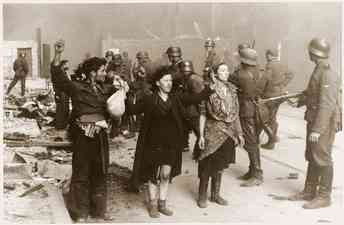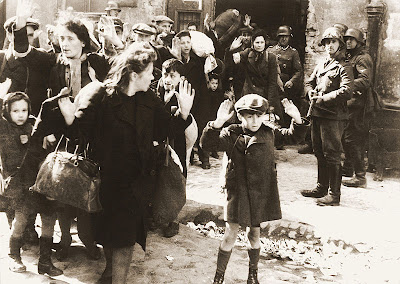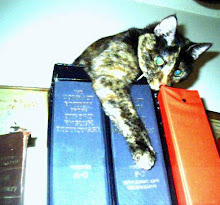 (Renny Kurshenbaum, Warsaw ghetto resistance fighter, circa 1939 -- more about her below)
(Renny Kurshenbaum, Warsaw ghetto resistance fighter, circa 1939 -- more about her below)
Today, April 19, is the 65th anniversary of the beginning of the Warsaw Ghetto Uprising. That year, too, it began on Passover Eve. This was the largest act of resistance by Jews against the Nazis.
Not long afterward, a Lithuanian Jew named Hirsh Glick, incarcerated in an Estonian concentration camp, wrote a song commemorating the spirit of resistance, Zog Nit Keynmol (which means "Never Say" in Yiddish). It is also known as Song of the Partisans. Glick was killed in 1944, but his song lives on. The final words of the first and last stanzas are Mir zaynen do -- We are here!
Below is a video of the Concerto a Chiari performing Zog Nit Keinmol.
Lyrics (English translation):
Never say this is the final road for you,
Thought leadened skies may cover over days of blue.
As the hour that we longed for is so near.
Our step beats out the message -- we are here!
From lands so green with palms to lands all white with
snow.
We shall be coming with our anguish and our woe,
And where a spurt of our blood fell on the earth,
There are courage and our spirit have rebirth.
The early morning sun will brighten our day,
And yesterday with our foe will fade away.
But if the sun delays and in the east remains--
This song as password generations must remain.
This song was written with out blood and not with lead,
It's not a little tune that birds sing overhead,
This song a people sang amid collapsing walls,
With grenades in hands they heeded to the call.
Therefore never say the road now ends for you,
Though leadened skies may cover over days of blue.
As the hour that we longed for is so near,
Our step beats out the message -- we are here!
Lyrics (in original Yiddish):
Zog nit keynmol az du gayst dem letzten veg,
Ven himlen blayene farshteln bloye teg;
Vayl kumen vet noch undzer oysgebenkte shuh,
Es vet a poyk tun undzer trot - mir zaynen do!
Fun grinem palmenland biz land fun vaysen shney,
Mir kumen un mit undzer payn, mit undzer vey;
Un voo gefalen iz a shpritz fun undzer blut,
Shpritzen vet dort undzer gvure, undzer mut.
Es vet di morgenzun bagilden undz dem haynt,
Un der nechten vet farshvinden mitn faynt;
Nor oyb farzamen vet di zun in dem ka-yor,
Vi a parol zol geyn dos leed fun door tzu door.
Geshriben iz dos leed mit blut und nit mit bly,
S'iz nit keyn leedl fun a foygel oyf der fry;
Dos hut a folk tzvishen falendi-ke vent,
Dos leed gezungen mit naganes in di hent.
Zog nit keyn mol az du gayst dem letzten veg,
Ven himlen blayene farshteln bloye teg;
Kumen vet noch undzer oysgebenkte shuh,
Es vet a poyk tun undzer trot -- mir zaynen do!
After the fold, I'll print the story of the uprising, along with historical photos that may be very hard for you to see. (Walling off the Warsaw ghetto, August 1940)
(Walling off the Warsaw ghetto, August 1940)
From Aish HaTorah, the Warsaw Ghetto Uprising:
The Warsaw Ghetto originally contained almost 450,000 people. By January of 1943, it was down to roughly 37,000 people. The rest had already been taken away to slave labor or death camps. Word got out that the Germans were going to finish off the ghetto, clean it out. Those half-starved, disease-weakened ghetto inhabitants decided to fight. (Emaciated Jewish children in the Warsaw ghetto)
(Emaciated Jewish children in the Warsaw ghetto) (A child dying in the streets of the crowded Warsaw Ghetto)
(A child dying in the streets of the crowded Warsaw Ghetto)
They had actually been preparing for this, and had convinced the Germans to let them build 631 air-raid shelters. Bombing was going on all around them, and the Germans needed their slave laborers so, to keep them safe from Allied bombings, the Germans had allowed them to do this. Now the people used those very shelters to fight against the Germans.
When the Germans came in to clean out the ghetto, much to their surprise, they were met with resistance.
There were over a thousand fighters, including children. They used pistols and Molotov cocktails against the Nazi weaponry, and they successfully repulsed the Germans. (Captured during the uprising)
(Captured during the uprising)
It was a short-lived victory. The Germans returned a short while later. This time they brought major fire power. They started to destroy buildings, bit by bit by bit, knocking everything down. After about a day, they broke into the hospital, shot everyone in their beds, and torched the place. Gradually, they destroyed the entire ghetto. (A family marching at the head of a column of Jews on their way to be deported during the Warsaw Ghetto Uprising in 1943)
(A family marching at the head of a column of Jews on their way to be deported during the Warsaw Ghetto Uprising in 1943)
When the Nazis reached the air-raid shelters, they drilled down, and gassed the people inside. Some fighters escaped to the sewers, and the Germans raised the water levels. The main fighting was over by May 16, 1943.
Most of the remaining Jews were rounded up, but it actually took months and months of combing through the ruins and demolishing the destroyed buildings before the uprising was finally put down. (Jews in the Warsaw ghetto surrender to German stormtroopers; one of the most famous images of World War II)
(Jews in the Warsaw ghetto surrender to German stormtroopers; one of the most famous images of World War II)
Although the Warsaw Ghetto Uprising was not really very successful, it was the first time in all of German-occupied Europe that there was any organized uprising against the Nazis. Word got out, and it set a climate. And afterwards, there was Jewish resistance in many other places, including some of the camps.
While the Warsaw Ghetto was fighting for its life, the world had called another conference. They met in Bermuda and, again, absolutely nothing was done to help. (Diary from unknown young woman during the Warsaw Ghetto Uprising)
(Diary from unknown young woman during the Warsaw Ghetto Uprising)
From the Claims Conference website:
The only surviving diary written from inside the Warsaw Ghetto uprising emerged in 2004 from the archives of Beit Lohamei Haghetaot (Ghetto Fighters’ House) in Israel. The six-page diary was written by an unknown young woman, who described the fires raging through the ghetto as the Nazis attempted to control the uprising.
The diary pages are part of a large collection of letters, notes and pages collected after the war by Adolf-Abraham Berman, a survivor of the ghetto and leader of the Jewish Underground who moved to Israel after the war. The museum realized the importance of the diary pages while organizing the Berman archive for release to the public. The writer, whose fate remains unknown, wrote from a basement for nine days, beginning on April 24, 1943, the sixth day of the uprising.
“The ghetto is burning for the fourth day,” she wrote. “You see only chimneys standing and the skeletons of burnt houses. At the first moment, the visions arouse a horrible chill.” She wrote that she was a member of a Jewish youth group, indicating that she was in her late teens or early 20s. “The only thing we are left with is our hiding place,” she wrote in her last entry, on May 2. “Of course this will not be a safe place for very long. We live this day, this hour, this moment.” (Renny Kurshenbaum while she was a courier for the resistance)
(Renny Kurshenbaum while she was a courier for the resistance)
Janet Tiger has written a play about one young woman, Renny Kurshenbaum, who was a resistance fighter, survived the ghetto, escaped from a Nazi death camp, and eventually came to America. She never found her little son, Jurek, though she searched for word of him over sixty years, until her recent death. Renny's biography and genealogy can be found at Renny's Story.
Saturday, April 19, 2008
ZOG NIT KEYNMOL
Posted by
Maggie Jochild
at
11:59 PM
![]()
Labels: Concerto a Chiari, Hirsh Glick, Jewish resistance, Passover, Renny Kurshenbaum, Warsaw Ghetto Uprising, Zog Nit Keynmol
Subscribe to:
Post Comments (Atom)





2 comments:
Thank you for this blog. Very moving, and amazing stories.
Cool, that was very interesting so, thanks!
Post a Comment